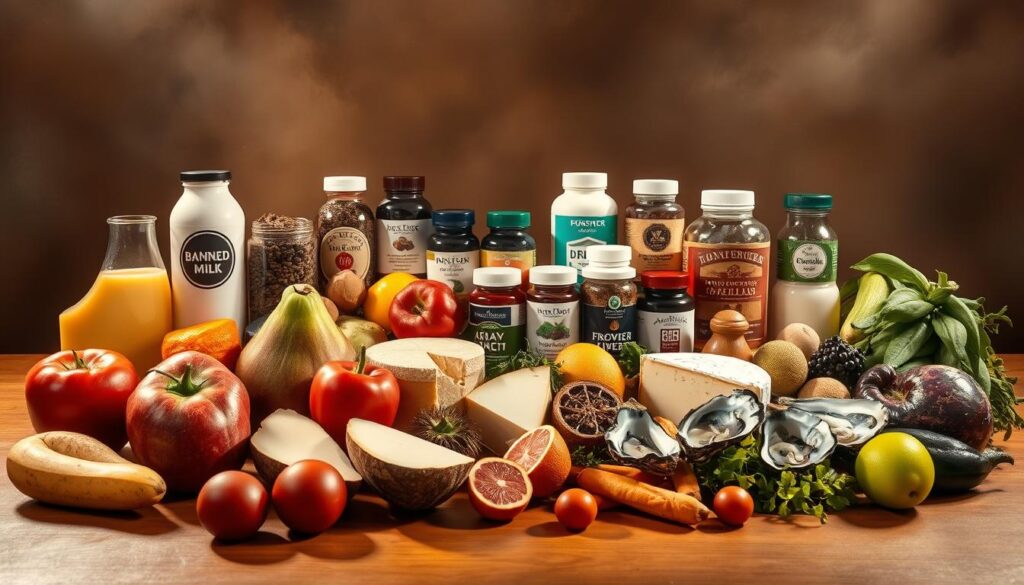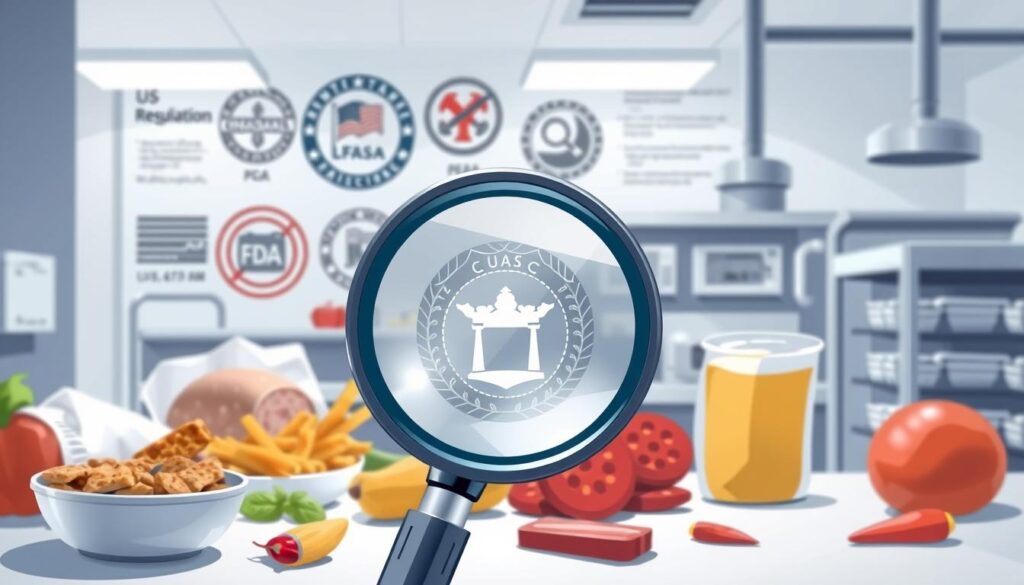Banned Foods – In the United States, we have a wide variety of foods to choose from. Yet, some foods are banned in certain states. These banned foods vary a lot, and it’s key to know why they’re restricted. They might be banned for health reasons, environmental concerns, or cultural reasons.

Knowing which foods are banned in some states helps us make better choices. From raw milk to rare foods, many items are off-limits. By looking into banned foods, we learn more about food industry rules.
Key Takeaways Banned Foods
- Foods banned in some US states can vary greatly depending on the region and cultural context.
- Banned foods can include items prohibited due to health concerns, environmental issues, or cultural sensitivities.
- Understanding which foods are banned can help consumers make informed decisions about their diet and lifestyle.
- The list of banned foods in the US includes raw milk, exotic delicacies, and other items.
- Exploring the world of banned foods can provide insight into the complex regulations surrounding the food industry.
- Some banned foods may be available in other countries, but are restricted in the US due to safety concerns.
Understanding Food Bans in America
Food laws in the United States are complex. They involve both federal and state governments. The FDA is key in keeping food safe for everyone.
Food rules come from both the federal and state levels. The federal government sets national food safety standards. But, states can also make their own rules. This can sometimes cause confusion for food makers and buyers.
Important parts of food rules include inspection and enforcement. These ensure food is safe. The FDA works with state agencies to check food and follow laws. Knowing these rules is crucial for everyone to follow US food safety laws.
What leads to food bans includes:
- Food safety concerns
- Environmental impact
- Animal welfare
These reasons show why following food rules and US food safety laws is so important.
The History Behind American Food Prohibitions
Food bans have been a part of American history. They were shaped by social, cultural, and economic factors. Understanding the historical context of these bans gives us insight into why they happened.
Concerns over public health, environmental impact, and economic interests have driven food bans. For example, early 20th-century food preservation methods revealed harmful substances in some foods. This led to bans. The government has enforced these bans, working with federal and state agencies to regulate the food industry.
Food bans have changed over time, addressing issues like food safety and sustainability. These bans have deeply impacted American culture and society. By looking at the history of food prohibitions, we can better understand the complex factors influencing our food landscape and the ongoing debate around food bans.
Foods Banned in Some US States: State-by-State Breakdown
Different US states have their own rules about restricted edibles and edible restrictions. Knowing these rules helps people make better food choices. We’ll look at the foods banned in various US states, sorted by region.
These edible restrictions aim to keep people safe and healthy. For example, some states ban raw milk to avoid contamination. Others limit seafood sales to prevent overfishing and protect the environment.
- Northeast: Raw milk, certain types of seafood
- South: Fried insects, certain types of wild game meat
- Midwest: Certain types of raw meat, unpasteurized cheese
- West: Certain types of exotic animals, such as alligator and snake meat
These edible restrictions change from state to state. It’s key to know the local laws before eating any food. By understanding these rules, people can enjoy a safe and healthy diet.
Raw Milk: The Most Controversial Food Ban
The debate over raw milk is heated, with many seeing it as a food safety concern. It’s banned in many places in the U.S. because of the risk of E. coli and Salmonella. These bacteria can cause serious health problems.
Yet, some people believe raw milk is good for you. They say it helps with digestion and is more nutritious. But, the risk of getting sick from it has led to bans in many states. The FDA has strict rules for dairy products, including raw milk, to keep everyone safe.
Raw milk is just one of many banned foods in the U.S. Bans are put in place to protect our health and stop foodborne illnesses. Some might think these bans are too strict. But, they aim to keep our food safe and prevent harm.
Here are some reasons why raw milk is banned:
- Risk of bacterial contamination
- Potential for foodborne illness
- Lack of standardization in production and distribution
The debate over raw milk shows the complex issues of food safety concerns and banned foods in the U.S. As consumers, knowing about these issues helps us make better choices about what we eat.
International Foods Prohibited on US Soil
The United States has strict food regulations to keep its citizens safe. Many international foods are not allowed in the country. This is because of health risks, environmental concerns, or cultural differences.
Some European cheeses and cured meats are banned in the US. This is because of contamination risks or banned ingredients. Also, some Asian seafood and spices are not allowed. This is due to food safety and environmental concerns.
Examples of Prohibited Foods
- Casu marzu, a Sardinian cheese that contains live maggots
- Fugu, a Japanese delicacy made from pufferfish that can be deadly if not prepared correctly
- Hákarl, an Icelandic fermented shark dish that is high in mercury
These food prohibitions affect international trade and cultural exchange. But they are there to protect US health and safety. Understanding these food regulations shows the value of safe food production and consumption.
Even though some foods are banned, there are similar alternatives. These alternatives let us enjoy other cultures’ flavors and traditions. They also follow US food regulations.
Health and Safety Reasons Behind Food Bans
The US food safety laws are key in keeping consumers safe from bad foods. Food bans stop diseases from spreading and keep everyone healthy. They aim to block foods that could harm our health.
Things like foodborne illnesses, allergic reactions, and harmful chemicals lead to bans. The laws make sure food is safe from start to finish. This ensures it meets high safety standards.
Here are some key points to consider:
- Food bans often happen because of foodborne illnesses, like salmonella or E. coli outbreaks.
- Allergens, such as peanuts or gluten, can also cause food bans.
- Contamination from harmful chemicals or toxins, like pesticides or heavy metals, leads to bans.

In conclusion, food bans are vital for public health. Knowing about US food safety laws and why foods are banned helps us choose better. This way, we can stay healthy and safe.
Cultural Impact of Restricted Foods
The cultural impact of food bans is a big deal. Traditional foods often get regulated, hurting community heritage and identity. This can threaten the cultural diversity of the United States.
Communities react to food bans in many ways. They might hold protests and petitions. Some cities even have food festivals to celebrate their culture and food.
- Organizing protests and rallies to raise awareness about the issue
- Starting petitions to appeal to local authorities to reconsider the bans
- Establishing alternative food sources, such as community gardens or farmers’ markets
The cultural impact of restricted foods is complex. It affects not just the food industry but also community identity. By understanding these effects, we can find ways to balance food safety and cultural preservation.
The Future of Food Regulations in America
As the food scene in the United States changes, food safety concerns grow more critical. Many foods banned in some US states highlight the need for new laws. The FDA and other groups are tackling issues like climate change’s effect on food and new food tech, Banned Foods.
Some key areas for future food laws include:
- Enhanced food tracing and recall systems
- Increased oversight of food imports
- Stricter rules on food additives and ingredients
These steps aim to keep consumers safe and ensure food is both safe and sustainable. As the food world adapts to new needs and tech, keeping up with food safety and laws is vital.

In the next years, food production, processing, and distribution will see big changes. By tackling food safety concerns early, we can build a healthier, sustainable food system. The future of food laws in America will blend consumer wants, tech innovation, and changes in foods banned in some US states.
Alternative Options for Banned Foods
In the United States, dealing with food regulations can be tough, especially for banned foods. But, there are ways to get these foods. You can find imported or made-in-the-USA versions in specialty stores or online.
Online marketplaces or direct sales are good ways to get banned foods. Some farms and producers offer community-supported agriculture (CSA) programs. This lets you buy shares of their products, including banned ones. Also, some companies import and sell international foods, even if they’re banned in some US states, Banned Foods.
Looking for similar products that aren’t banned is another option. For example, if a cheese is banned in some places, you might find a similar one made in the US or imported from a country with less strict rules. Banned Foods, This way, you can enjoy your favorite foods while following food regulations.
Some popular alternatives to banned foods include:
- Domestically produced cheese and dairy products
- Imported meats and poultry from countries with similar food regulations
- Specialty foods made from alternative ingredients
Conclusion: Banned Foods
The complex system of food bans and US food safety laws is key to keeping Americans healthy. It includes rules on raw milk and bans on certain international foods. This system is always changing to meet new challenges and protect consumers.
Some might see these rules as too strict. But they are crucial for keeping people safe from bad or contaminated food. By keeping up with changes, we can keep our food safe and promote smart shopping.
It’s important for us to know about new food safety rules. This helps us make better choices and support policies we believe in. Together, we can enjoy food while keeping everyone safe and healthy.
FAQ
What is the purpose of this section?
This FAQ section answers common questions about banned foods in some US states. It covers why these bans happen, the laws behind them, and how they affect communities.
What are some examples of foods that are banned in certain US states?
Banned foods include raw milk, unpasteurized cheese, and foie gras. Shark fins and exotic meats are also banned in some places. The rules vary by state.
How are food bans enacted in the United States?
Food bans come from both federal and state laws. The FDA sets national standards. States can add their own rules based on local needs.
What are the main reasons behind food bans in the US?
Bans are mainly for health and safety, environmental reasons, and cultural or religious beliefs. They aim to stop foodborne illnesses and protect consumers.
How do food bans impact cultural and traditional foods?
Bans limit access to cultural and traditional foods. This can cause tension and controversy in affected communities.
What are the debates surrounding raw milk bans in the US?
Debates on raw milk bans are intense. Supporters see health benefits, while critics worry about safety. This shows the challenges of food bans.
Are there any international foods that are prohibited from being imported into the US?
Yes, some international foods are banned in the US. This includes certain European cheeses and Asian meats. Bans are often for health or trade reasons.
What are some alternative options for consumers who are affected by food bans?
Affected consumers can look for similar products, check online marketplaces, or push for changes in food laws.
Source link
- https://www.fda.gov/inspections-compliance-enforcement-and-criminal-investigations/compliance-actions-and-activities/fda-debarment-list-drug-product-applications
- https://www.aphis.usda.gov/traveling-with-ag-products
- https://www.fda.gov/food/hfp-constituent-updates/fda-revoke-authorization-use-red-no-3-food-and-ingested-drugs
- https://www.fda.gov/food/food-ingredients-packaging/food-additive-listings
- https://www.fda.gov/food/color-additives-information-consumers/color-additives-foods
